“Like ‘Webster’s Dictionary,’ I Was Morocco Bound”
The Polemicist
by Michael House
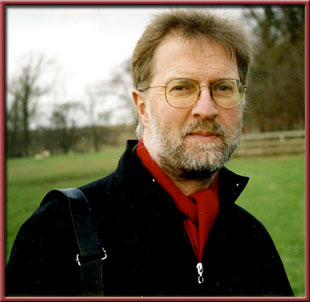 LONDON, England—(Weekly Hubris)—5/31/10—7 p.m., Sunday night, Gatwick Airport. The airborne ash-cloud from the Icelandic volcano was making its way inexorably southwards. Manchester Airport was closed and Birmingham was about to be, confounding the unfortunates who had hurtled down the M6 in coaches and taxis.
LONDON, England—(Weekly Hubris)—5/31/10—7 p.m., Sunday night, Gatwick Airport. The airborne ash-cloud from the Icelandic volcano was making its way inexorably southwards. Manchester Airport was closed and Birmingham was about to be, confounding the unfortunates who had hurtled down the M6 in coaches and taxis.
The Royal Air Maroc flight to Marrakech would be boarding at ten past eight, said the indicator board, for take-off at 9 p.m. Then, it became 9.10; then 9.25. Diane and I were getting increasingly twitchy. Ten past eight came and went. Boarding was put back to 8.25, which (also) came and went without a boarding gate being posted. We began to fear the worst.
I asked at the information desk. The man said he didn’t know why the gate number wasn’t up on the board but, just between ourselves, it was gate 101. This added an appropriately Orwellian edge to our fears.
We made the 20-minute trek to gate 101 and, Lo, there it was, illuminated: Flight AT 693 to Marrakech. We were almost certainly the last flight out of Gatwick before the ash cloud arrived. Three hours later, we landed.
Unfortunately, no one had warned Marrakech Airport that we were coming. So the taxi-driver sent from the riad (old house turned into an up-market B & B) had looked at the indicator board, seen no reference to our flight, and taken himself off. A frantic call to the riad after midnight finally produced a taxi. Our luggage was off-loaded but, since we were not expected, there was no indication of which of several carousels we should wait by. Frantic rushing from one to the other of four possible candidates finally produced results.
So, by 1.30 a.m. we were finally sipping mint tea in the Riad Dar El Masa (details below, highly recommended).
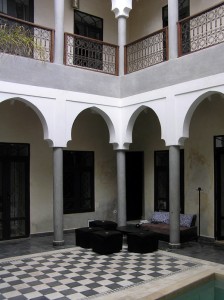
Like most riads, Dar El Masa is in an obscure cul-de-sac behind a blank wall. It is built around a courtyard with a small swimming-pool situated in the middle. The central atrium is open to the sky, which is fine in the daytime but dire at night. Every sound of an extremely raucous city may then be heard, from rock groups playing in the great central square Jamaa El ‘Fna (‘assembly of the dead,’ where the kings once displayed the heads of their enemies, as you wish you yourself might do), to the dreadful Islamic yowlings, heavily amplified, known as the call to prayer.
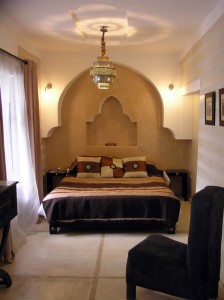
These are supposed to occur five times a day, the first being at daybreak, a very elastic concept in Marrakech (usually around 4.30 a.m.). There are, of course, several different mosques in town, and the imams pride themselves on making their own calls louder than those of their rivals, rather than playing the normal taped recordings, so the hideous cacophony may well be imagined. What may be tolerated with a superior smile as harmless superstitious nonsense in the daytime, becomes a human rights violation at night. One positive note? In daylight, the sensible folk of Marrakech appear to ignore any and all calls to religious action and carry on with their secular business.
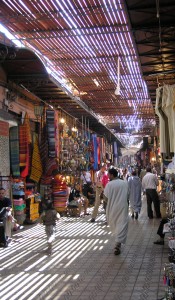
Marrakech is not a destination for the faint-hearted. It comprises a violent assault on the senses. All of them. The souk (market complex) is an aural and visual bombardment. Walk along the narrowest alley imaginable, and carts pulled by sad-eyed mules, whipped into hauling heavily-loaded carts, will miss you by inches, as will tinkling cycles and hooting scooters. The colors, the noise, the smells, the sheer intensity of the souk make an hour’s visit the maximum dose for a Western adult. But utterly exhilarating, I might add.
The Jamaa El ‘Fna is a huge open space, across which traffic passes and people stroll at random and at their own risk. All human (and much animal) life is on display here. Unhappy Barbary apes are held on chains for tourists to photograph and gawp at. A pipe-blowing character out of the Arabian Nights will drape his (presumably defanged) cobra around your neck for a few dirhams (and remove it for a few more.) Beggars, would-be guides, vendors of baskets, straw hats, single cigarettes, phone cards, fortunes, aphrodisiacs and Korans, throng the square.
Time to retreat to a restaurant for lunch, where the ubiquitous tajine and couscous make a delicious meal. We are served by an elderly waiter who has two words of English when producing the food, delivered like an elderly sheep clearing its throat on a distant hillside (c. P.G.Wodehouse): “Ve-r-r-r-y N-i-i-ice.”
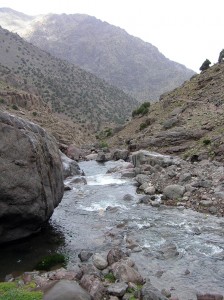
Marrakech is a wonderful city [on no account, miss the 16th century Ben Youssef Madersa (Koranic school), one of the highlights of Moorish Islamic architecture in North Africa], but a little goes a long way. So, after three days we retreated south into the High Atlas mountains, the 400-mile-long range that keeps the Sahara at bay.
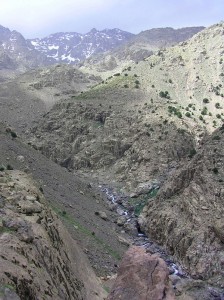
Our destination was the Kasbah Du Toubkal, according to the Sunday Times one of the world’s 100 greatest hotels. It is a co-operative venture between a travel company and local Berbers from the village of Imlil, a few hundred yards below the Kasbah. They prefer to call themselves a Berber hospitality center rather than a hotel. The Kasbah (fortress of a provincial governor or Caid) sits on a knoll at about 6,000 feet. Dominating the skyline at 13,500 feet is Mount Toubkal, snow-flecked even in late May, the highest mountain in North Africa and second only to Kilimanjaro on the African continent. Everywhere is rushing water, audible day and night, pouring down from the glaciers to join the turbulent river that has carved the twisting valley down to the plain. Walnut, cherry and apple trees shade the stony paths from village to village. It is a magical place. The road stops below the Kasbah, so our luggage was brought up the track in the panniers of one of the innumerable mules that carry luggage for trekkers in the mountain complex.
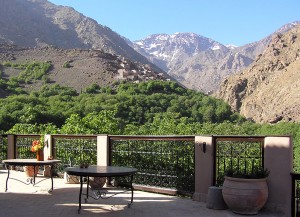
The rooms in the main building—the watch-tower built especially for Martin Scorsese’s 1997 film, Kundun, about the life of the Dalai Lama—and the cabins dotted about the gardens, are equipped with traditional Berber carved furniture and elegant hand-knotted rugs. Not luxurious, but very comfortable. Meals are served in the opulent splendor of the main hall, featuring robust Moroccan cuisine and plenty of it. The signature dish is tajine, a pyramidal earthenware pot in which meat and vegetables simmer for hours till the meat drops off the bone. Alcohol is not served, but you can bring your own.
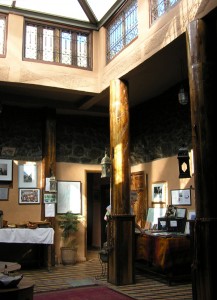
The highlight of this part of the trip was a long walk up the mountain. To get to the top takes two days for a reasonably fit person; 6-7 hours to the lodge/refuge just below the final peak; and then, on the next morning, 3 hours to the summit. With a heavy cold, I didn’t feel “reasonably fit,” so I limited myself to a five-hour hike up to the snowline, a few hundred feet above a shrine at Sidi Chamharouch, said to be pre-Islamic, although Muslim pilgrims apparently visit to be cured of mental illness, the modern version of casting out devils. The shrine is also a commercial undertaking, with the usual mixture of beautiful objects and tourist tat. Expect lots of hassle from the local vendors. The path up the mountain is a very easy one, impossible to miss, the views superb with spectacular waterfalls. There is no chance of getting lost. Mule trains pass up and down the trail all day long.
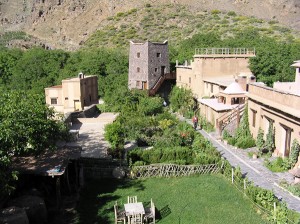
On the way back, we passed through the highest Berber village in the valley, Armed. There, we encountered a character who called himself Berber Robin Hood Number 2 (real name: Ibrahim). His apparent aim was to take from the rich—us—and give to the poor—him. His shop contained many beautiful objects, including plates made from mountain stone containing fossils millions of years old from when the Atlas and the Sahara ranges were beneath the sea. He was a born salesman, with a knack of drawing the potential customer in without applying any pressure (a technique all shopkeepers should learn). We came away with several fossil dishes, an inlaid wooden box, and a black Berber carpet with designs corresponding to the tattoos on the faces of Berber women which depict their matrimonial status and the number of children they have produced.
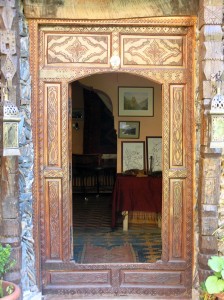
An excellent Moroccan charity is Education for All, which focuses on educating girls in rural Morocco (www.educationforallmorocco.org).
PS: I like contrasts in my vacations. The week previous to Diane’s and my Moroccan sojourn, I spent pottering along England’s north Norfolk coast, exploring bird sanctuaries, used bookstores, and churches. None of this proved very polemical, though, so I hope to be back in full ranting mode in two weeks’ time (with or without illustrative tattoos).
PS 1: Further Instructions for the Faint of Heart, Not:
Dar el Masa Riad: 35 derb Jdid, Marrakech Medina, Marco. E-mail: darelmasa@yahoo.fr; Website: www.riadelmasa.over-blog.com; Tel: 00 212 (0) 24 381 184; or 00 212 (0) 524 38 69 39.}
Kasbah du Toubkal, Imlil, Nr. Marrakech. E-mail: kasbah@diskover.ltd.uk; Tel: in UK + 44 (0) 1883 744 392; Website: www.ksbahdutoubkal.com
PS 2: Michael House’s most-execrable-pun-in-his-column-title was NOT coined by his editor.
3 Comments
Michael House
Taken from a song in the Crosby/Hope film “The Road to Morocco.” MH.
eboleman-herring
In fact, as you know, I am the Uncrowned Queen Of Execrable Puns, so I loved it (AS do I love the Hope/Crosby films)! e
ejaz14357
The Road to Morocco.i like it.